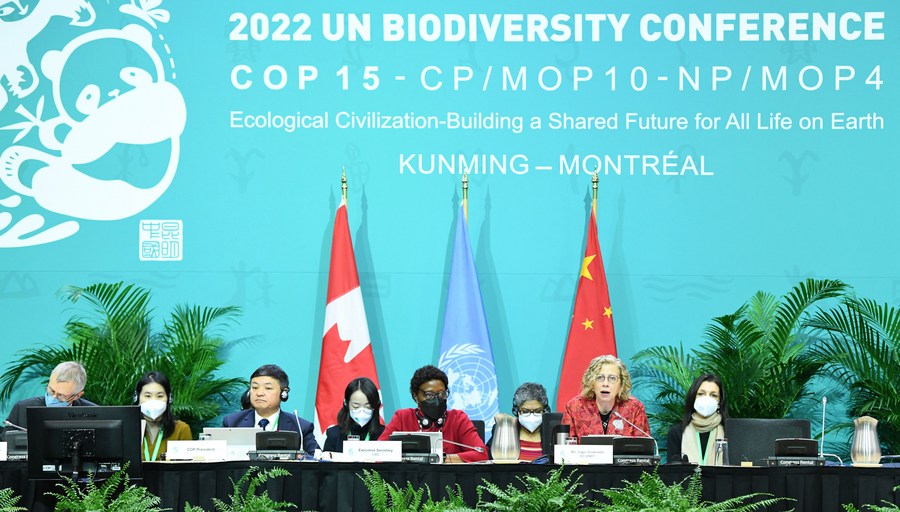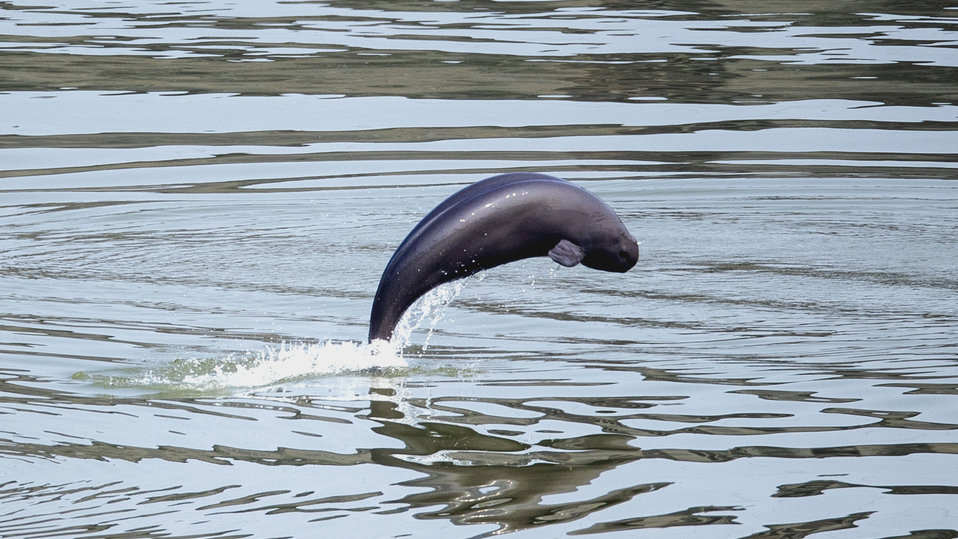
The opening ceremony of the second phase of the 15th meeting of the Conference of the Parties to the UN Convention on Biological Diversity in Montreal, Canada, December 7, 2022. /Xinhua
The opening ceremony of the second phase of the 15th meeting of the Conference of the Parties to the UN Convention on Biological Diversity in Montreal, Canada, December 7, 2022. /Xinhua
Editor's note: Jiang Zhigang is a professor in Conservation Biology at the University of Chinese Academy of Sciences. He mainly focuses on inventory, red list assessment, and conservation of animal diversity. The article reflects the author's opinions, and not necessarily those of CGTN.
The global society has reached a consensus on protecting biodiversity, as 196 parties ratified the UN Convention on Biological Diversity (CBD). The 15th Meeting of the Conference of the Parties (COP15) to the CBD is held in Montreal, Canada. The parties are discussing "The Post-2020 Global Biodiversity Framework," to achieve the goal, "Living in harmony with nature by 2050."
The framework addresses underlying causes of biodiversity loss, to reduce pressures and to promote the sustainable use of biodiversity by safeguarding ecosystems, species, and genetic diversity, to enhance the benefits to humans from biodiversity and ecosystem services. It requires urgent actions from all stakeholders to transform traditional economic, social, and financial development, so that biodiversity erosion will stabilize by 2030 and the natural ecosystem can recover in 2040 and improve by 2050.
Biodiversity refers to the diversity of genes, proteins, individuals, species, ecosystems, and biome levels. We are concerned about three primary levels: genetic, species, and ecosystem diversities. Biodiversity could be divided into taxonomic groups such as the diversities of fungi, lichens, mosses, ferns, gymnosperms, flowering plants, corals, soft-boned fishes, hard-boned fishes, amphibians, reptiles, birds, and mammals. Losing genes may reduce individuals' adaptability to environmental changes and harm their viability, thus threatening species' survival.
Losing species alters ecosystem structure and may affect ecosystem functions, including carbon sequestration, water purification, preventing soil erosion, and local climate regulation, thus harming human society. The UN Food and Agriculture Organization (FAO) considers crop varieties and domestic breeds as genetic resources. To ensure food production, people can choose from available crops and domestic animal varieties that adapt to extreme climates and resist pests for different agriculture systems in areas with different climates and soil types. Thus, biodiversity is the cornerstone of the biosphere, the natural capital for social development, and the foundation of human society.
We are facing a biodiversity crisis; genetic diversity in many plants and animals has eroded. The FAO reported that 75 percent of the world's food is generated from only 12 plants and five animal species nowadays. Since the 1900s, three-quarters of plant genetic diversity has been lost as farmers worldwide abandon traditional local crop landraces for high-yielding varieties. Thirty percent of livestock breeds are at risk of extinction. Many plant and animal species in the wild are endangered, even extinct, due to habitat loss and human activity, and ecosystem structure is damaged.

A Yangtze finless porpoise jumps out of the water in the lower reaches of the Gezhouba Dam in Yichang City, central China's Hubei Province, November 9, 2022. /Xinhua
A Yangtze finless porpoise jumps out of the water in the lower reaches of the Gezhouba Dam in Yichang City, central China's Hubei Province, November 9, 2022. /Xinhua
According to the IUCN Red List of Threatened Species, 69 percent of cycads, 34 percent of conifers, 36 percent of reef-forming corals, 37 percent of sharks, rays & chimeras, 41 percent of amphibians, 21 percent of reptiles, 13 percent of birds and 27 percent of mammals worldwide are threatened by habitat loss and over-exploitation. The causes of the biodiversity crisis are the growing human population and over-consumption.
As the human population grows and ecological footprints, in terms of the lands needed for producing food, timber and fiber, absorbing carbon dioxide, and constructing the infrastructure per capita, also increase. We have exploited most inhabitable places to make room for human settlements and agriculture on Earth, leaving little room as habitats for the wildlife. Humans discharge ever-increasing solids, water, and gas wastes and pollute the environment. Tropical forests are clearly-logged, and wetlands are drained to produce cash crops and foods. The ecosystem service of land vegetation that absorbs carbon dioxide, stops rainfall runoff, and prevents soil erosion and of the wetland for flood regulation and carbon fixation are lost.
The COP15 plays a crucial role in stopping biodiversity loss and restoring the natural environment by implementing "The Post-2020 Global Biodiversity Framework." Governments and stakeholders need to internalize the value of nature and recognize the cost of inaction. Meanwhile, progress toward the 2030 Sustainable Development Goals adopted by all United Nations member states in 2015 can create the conditions necessary to implement the framework. Governments and stakeholders should determine priorities and allocate financial and other resources to make the changes needed over the next ten years to achieve the 2050 Vision.
The industrialized countries of the northern hemisphere should talk with developing countries in the southern hemisphere and take a reasonable share of the responsibility for protecting global biodiversity. As chairperson of COP15 to the CBD, China remains committed to biodiversity conservation, as well as rescuing endangered species, safeguarding genetic diversity and ecosystems, and improving human welfare by protecting biodiversity.
(If you want to contribute and have specific expertise, please contact us at opinions@cgtn.com. Follow @thouse_opinions on Twitter to discover the latest commentaries on CGTN Opinion Section.)